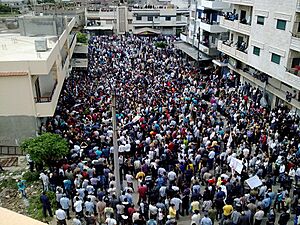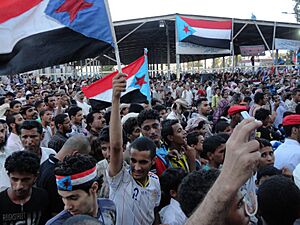Arab Spring facts for kids
Quick facts for kids Arab Spring |
|
|---|---|
| Part of modern conflicts in the Middle East and North Africa | |
|
Protesters in Tahrir Square, Cairo, Egypt; Protesters in Tunis, Tunisia; Protesters in Sanaa, Yemen; Crowds in Baniyas, Syria |
|
| Date | 17 December 2010 – December 2012 (about 2 years) |
| Location | |
| Caused by |
|
| Goals |
|
| Methods |
|
| Resulted in | Some governments were overthrown, followed by a period known as the Arab Winter and the 2018–2024 Arab protests.
Results by country
|
| Casualties | |
| Death(s) | Over 61,000 deaths in total (international estimate) |
The Arab Spring was a series of protests and uprisings that spread across the Middle East and North Africa in the early 2010s. People in many Arab countries were unhappy with their governments. They wanted more democracy, better jobs, and an end to unfair practices.
The movement began in Tunisia and quickly inspired people in other countries like Egypt, Libya, Yemen, Syria, and Bahrain. In some places, leaders who had been in power for many years were forced to step down. In others, the protests led to major conflicts, including civil wars.
A famous slogan chanted by protesters was "ash-shaʻb yurīd isqāṭ an-niẓām!" This means "the people want to bring down the regime" in Arabic. The protests showed that many people, especially the youth, were ready to demand change.
By 2012, the first wave of protests began to fade. Many governments responded with force, and in some countries, this led to long and difficult wars. The period that followed is sometimes called the Arab Winter because the early hopes for change were met with new challenges and conflicts. Even today, countries like Syria, Libya, and Yemen are still dealing with the effects of these events.
Contents
What Does "Arab Spring" Mean?
The name "Arab Spring" was first used by writers in the West. It was inspired by other historical events, like the "Prague Spring" of 1968. The word "spring" suggests a time of new beginnings and hope for freedom.
However, many people who took part in the protests did not use this name. They often called their movements a "revolution" (thawra) or an "awakening" (sahwa). Some felt the name "Arab Spring" was too simple and did not capture the serious goals of the protesters.
Why Did the Protests Happen?
There was not one single cause for the Arab Spring. It was a combination of many problems that had been building up for years.
- Lack of Freedom: Many countries were ruled by leaders who had been in power for decades. People had little say in their government and could be punished for speaking out.
- Unemployment: Many young people, even those with a college education, could not find jobs. This created a lot of frustration.
- Poverty: A lot of people struggled to afford basic things like food. Prices for food were rising, making life even harder.
- Unfair Governments: Many people felt their governments were corrupt, meaning officials used their power for personal gain instead of helping the public.
- Inspiration from Others: When people in Tunisia successfully protested, it inspired others across the Arab world to believe that they could also make a change.
How It All Began in Tunisia
The Arab Spring started with one man's protest in Tunisia. On December 17, 2010, a young street vendor named Mohamed Bouazizi had his fruit cart taken away by a police officer. He felt he was treated unfairly and had no way to support his family.
In a desperate act of protest, he set himself on fire in front of a government building. His story spread quickly, and many Tunisians who felt the same frustration began to protest. They were tired of unemployment and unfair treatment by the government.
The protests grew larger and larger. After about a month of demonstrations, the president of Tunisia, Zine El Abidine Ben Ali, fled the country on January 14, 2011. He had been in power for 23 years. The success of the Tunisian Revolution showed people in other Arab countries that change was possible.
Key Events in Different Countries
Egypt: Protests in Tahrir Square
Inspired by Tunisia, protests in Egypt began on January 25, 2011. Hundreds of thousands of people gathered in Tahrir Square in the capital city, Cairo. They demanded that President Hosni Mubarak, who had ruled for 30 years, step down.
For 18 days, protesters occupied the square. The government tried to stop them by shutting down the internet and using police force. But the protests continued to grow. Finally, on February 11, 2011, Mubarak resigned. The army took control and promised to lead the country toward elections.
Later, Egypt held its first free presidential election. However, the country faced more challenges and protests in the years that followed.
Libya: A Civil War Begins
In Libya, protests against the country's longtime leader, Muammar Gaddafi, began in February 2011. Gaddafi's government responded with strong force, and the protests quickly turned into a civil war.
Rebel forces fought against Gaddafi's army. Other countries, with the approval of the United Nations, helped the rebels with air strikes to protect civilians. After months of fighting, the rebels took control of the capital city, Tripoli, in August 2011.
Gaddafi was captured and killed in October 2011, ending his 42-year rule. After he was gone, Libya struggled with instability and conflict between different groups for many years.
Syria: From Protests to a Long Conflict
Protests in Syria began in March 2011. People were calling for more freedom and for President Bashar al-Assad to make changes. The government responded harshly to the demonstrations.
The conflict grew worse and turned into a full-scale civil war. The war lasted for over a decade and caused a terrible humanitarian crisis, with many people losing their homes and lives. The fighting involved many different groups within Syria, as well as other countries.
In December 2024, rebel forces launched a major attack and took control of the capital, Damascus. President Assad fled the country, and his government fell after more than 50 years of his family's rule.
Yemen: A President Steps Down
Protests in Yemen started in January 2011. People demanded that President Ali Abdullah Saleh, who had been in power for over 30 years, resign.
After months of large demonstrations, Saleh finally agreed to step down in November 2011. He handed power over to his vice president. However, this did not bring peace to the country. Yemen soon fell into a complex civil war involving different groups and neighboring countries, which continues to cause great suffering.
Bahrain: A Call for Change
In February 2011, large protests began in Bahrain. Many protesters gathered at the Pearl Roundabout in the capital, Manama. They called for more political freedom and equality.
The government responded by clearing the protest camps with police and military force. It also asked for help from neighboring countries like Saudi Arabia and the United Arab Emirates, who sent troops to help stop the protests. The government made some promises for reform, but the main calls for change were not met.
What Happened After the Protests?
The results of the Arab Spring were very different from country to country. There were no easy or quick successes.
- Positive Changes: In Tunisia, the protests led to a new constitution and democratic elections. It is often seen as the most successful story of the Arab Spring.
- Difficult Transitions: In Egypt, the road after the revolution was rocky, with more political changes and instability.
- Civil Wars: In Syria, Libya, and Yemen, the uprisings led to long and devastating civil wars. These conflicts destroyed cities, created millions of refugees, and led to ongoing instability. This difficult period is often called the Arab Winter.
The Arab Spring showed that many people in the Middle East and North Africa wanted a better future. But it also showed how difficult it can be to achieve lasting change, especially when old rulers and systems resist.
Summary of Conflicts by Country
| Country | Date started | Status of protests | Outcome | Death toll | Situation |
|---|---|---|---|---|---|
| 18 December 2010 | Government overthrown on 14 January 2011 | President Zine El Abidine Ben Ali left the country.
|
338 | Government overthrown | |
| 25 January 2011 | Two governments overthrown (2011 and 2013) | President Hosni Mubarak overthrown.
|
846 | Two governments overthrown | |
| 26 January 2011 | Uprising turned into a civil war, government overthrown in December 2024. | Protests led to a long civil war.
|
656,493+ | Civil war, government overthrown | |
| 27 January 2011 | Government overthrown, followed by civil war. | President Ali Abdullah Saleh overthrown.
|
2,000 | Civil war and government overthrown | |
| 14 February 2011 | Protests were stopped by the government. | *The government, with help from neighboring countries, ended the protests.
|
120 | Protests stopped by government | |
| 15 February 2011 | Government overthrown, followed by more conflict. | Leader Muammar Gaddafi was overthrown and killed.
|
9,400–20,000 | Government overthrown and civil war | |
| 14 January 2011 | Ended in October 2012 | *The king made several changes to the government and the constitution in response to protests. | 3 | Protests and governmental changes | |
| 19 February 2011 | Ended in December 2012 | *The Prime Minister and his cabinet resigned.
|
None | Protests and governmental changes | |
| 20 February 2011 | Ended in April 2012 | *The king introduced a new constitution, which was approved by voters. | 6 | Protests and governmental changes |
See also
 In Spanish: Primavera Árabe (2010-2012) para niños
In Spanish: Primavera Árabe (2010-2012) para niños






